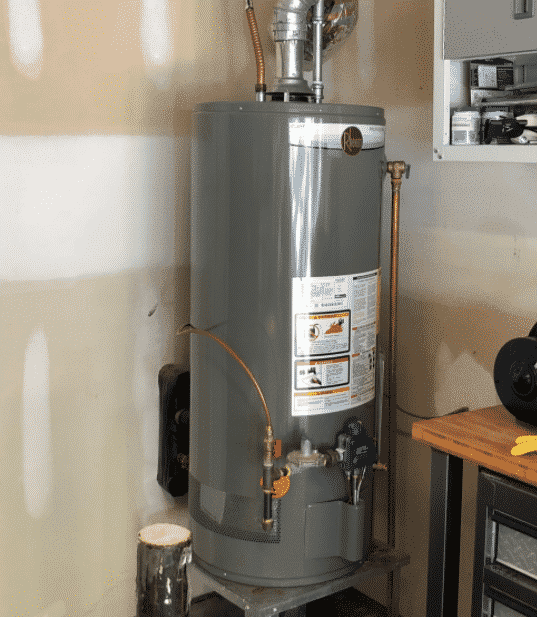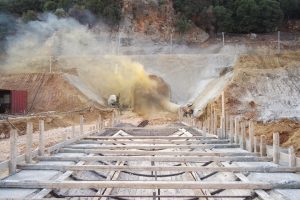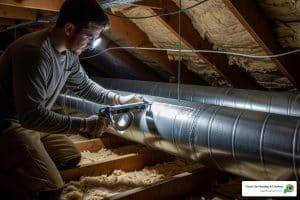Heat pump water heater rebate offers significant savings for homeowners seeking energy-efficient solutions for their hot water needs. By upgrading to a heat pump water heater, you can reduce your annual utility bills and enjoy substantial rebates and tax credits. Typically, eligible homeowners can claim a 30% tax credit of up to $2,000. Additionally, state and local programs often provide further rebates, reducing the out-of-pocket costs even further.
Switching to a heat pump water heater is not only vital for your wallet but also for the environment. Unlike traditional water heaters, heat pump models use existing heat from the air, leading to higher efficiency and lower carbon emissions. This means you can enjoy consistent hot water while contributing to a greener planet.
I’m Colin Matei, Owner and President of Clean Air Heating & Cooling. With years of experience in energy-efficient technology, I’ve guided numerous homeowners through maximizing their heat pump water heater rebate savings. Now, let’s explore how these rebates can transform your home’s energy profile.

What is a Heat Pump Water Heater?
A heat pump water heater is a modern and energy-efficient way to heat water for your home. Unlike traditional water heaters that generate heat directly, these innovative systems use electricity to move heat from the air into the water. This process makes them significantly more efficient.
Energy Efficiency
Heat pump water heaters are known for their impressive energy savings. They consume about one-third of the electricity used by standard electric water heaters. According to Energy.gov, heating water accounts for up to 18% of a home’s energy consumption. By switching to a heat pump model, homeowners can cut these costs dramatically.
How It Works
Think of a heat pump water heater as a refrigerator working in reverse. Here’s a simple breakdown:
- Heat Absorption: The system draws in warm air from the surroundings using a fan. This air passes over refrigerant-filled evaporator coils, warming the refrigerant.
- Compression: The warm refrigerant is then compressed, increasing its temperature and pressure. This step is crucial for heating the water efficiently.
- Heat Transfer: The hot refrigerant flows through condenser coils wrapped around the water tank. This process transfers heat to the water, raising its temperature.
- Cycle Continuation: After transferring its heat, the refrigerant cools down and returns to the evaporator coils to begin the cycle anew.

Heat pump water heaters need to be installed in areas where the temperature remains between 40°F and 90°F year-round. They work best in basements, garages, or utility rooms where these conditions are met.
By using existing heat from the air, these heaters offer a sustainable and cost-effective solution for your hot water needs. The heat pump water heater rebate programs make them even more attractive, providing financial incentives for homeowners ready to make the switch.
Federal Tax Credits for Heat Pump Water Heaters
Switching to a heat pump water heater not only saves energy but also offers financial benefits through federal tax credits. These credits are designed to encourage homeowners to adopt more energy-efficient technologies, reducing both their carbon footprint and utility bills.
30% Tax Credit
The federal government offers a 30% tax credit for the purchase and installation of eligible heat pump water heaters. This means you can deduct 30% of the total project cost from your federal taxes. However, there is a cap: the maximum amount you can claim in credits for a heat pump water heater is $2,000.
Eligibility Criteria
To qualify for this tax credit, several conditions must be met:
- ENERGY STAR Certification: Your heat pump water heater must be ENERGY STAR certified, ensuring it meets high energy efficiency standards.
- Principal Residence: The installation must be in your principal residence, which is the home where you live most of the time. New constructions and rental properties are not eligible.
- Efficiency Standards: The equipment must meet or exceed the highest efficiency tier set by the Consortium for Energy Efficiency in effect at the start of the calendar year.
Claiming Your Credit
Claiming this tax credit is a straightforward process. You’ll need to fill out and submit IRS Form 5695 when you file your federal tax return. This form is specifically for Residential Energy Credits and includes detailed instructions to help you calculate and claim your credit.
- Keep Your Receipts: Make sure to keep all receipts and documentation related to your purchase and installation. You may need these for verification purposes.
- Stay Within Annual Limits: While the credit for a heat pump water heater is capped at $2,000, the overall limit for energy efficiency tax credits in a year is $3,200.
By taking advantage of these federal tax credits, you can significantly reduce the cost of upgrading to a heat pump water heater, making it an even smarter investment for your home.
State and Local Rebates
When it comes to upgrading to a heat pump water heater, state and local rebates can significantly reduce your out-of-pocket costs. Programs in various states, such as Washington & Oregon, offer substantial financial incentives to encourage homeowners to make the switch.
Eligibility Criteria
Both Washington and Oregon have specific eligibility criteria for their rebate programs. For Washington specifically, rebates can be found through
- Cascade Natural Gas (CNGC):
- Residency: You must be a homeowner or tenant within the CNGC service area and on residential rate schedule 503.
- Approved Products: Only specific energy-efficient products qualify. These include high-efficiency furnaces, water heaters, and insulation upgrades. Check the full list on the CNGC website.
- Proper Installation: All installations must be performed by a licensed Washington contractor and meet CNGC’s installation guidelines.
- Documentation: Submit proof of purchase, installation details, and the completed rebate application form.
- Deadlines: Applications must be submitted within 90 days of installation.
- Puget Sound Energy (PSE):
- Residency: You must be a homeowner within the PSE service area and be an active PSE customer.
- Approved Products: Eligible products include energy-efficient heating systems, insulation, water heaters, windows, and smart thermostats. Refer to the complete list on the PSE website.
- Proper Installation: Installations must meet PSE’s guidelines and be completed by a certified professional.
- Documentation: Provide all necessary documentation including receipts, proof of installation, and the rebate application form.
- Deadlines: Submit your application within the specified timeframe, typically within 60 to 90 days of the upgrade.
By understanding and leveraging these state and local rebates, you can make upgrading to a heat pump water heater more affordable and environmentally friendly. This not only helps reduce your utility bills but also contributes to a cleaner planet.
How to Claim Your Rebates and Tax Credits
Claiming your heat pump water heater rebate and federal tax credits can be straightforward if you follow the right steps. Let’s break it down:
Federal Tax Credits
To claim your federal tax credit, you’ll need to fill out IRS Form 5695, which is used for Residential Energy Credits. This form helps you calculate your tax credit, which can be up to 30% of your project cost, with a cap of $2,000.
Steps to Claim:
1. Purchase and Install: Make sure your heat pump water heater is ENERGY STAR certified and installed in your principal residence in the U.S.
2. Complete IRS Form 5695: Fill out the form when you file your federal income tax return.
3. Keep Documentation: Save all receipts and documentation related to your purchase and installation. This includes model numbers and proof of ENERGY STAR certification.
State and Local Rebates
State and local rebates vary, so it’s important to check the specific programs in your area. For instance, California’s TECH Clean California offers rebates up to $3,800, while Maine’s Efficiency Maine provides instant discounts or mail-in rebates.
Steps to Claim:
1. Check Eligibility: Ensure your water heater meets the rebate program’s requirements, like ENERGY STAR certification.
2. Use Approved Contractors: For rebates through CNGC or PSE, your installation must be done by a participating, approved contractor.
3. Submit Applications: For mail-in rebates, send in your application with all required documentation, like receipts and model numbers, within the specified timeframe.
4. Combine Rebates and Credits: You can often combine state rebates with federal tax credits for maximum savings. Just ensure you meet all the requirements for each program.
Deadlines
Deadlines can vary, especially for state and local programs. Federal tax credits are available for purchases and installations made between January 1, 2023, and December 31, 2032. Always check the specific deadlines for your state or local rebates to ensure you don’t miss out.
By understanding the claim process and keeping track of required forms and deadlines, you can make the most of your rebates and tax credits. This not only lowers your initial investment but also makes your home more energy-efficient.
Next, let’s explore strategies to maximize your savings and see how you can spread improvements over several years to stay within annual limits.
Maximizing Your Savings
When it comes to maximizing your savings on a heat pump water heater rebate and federal tax credits, a little planning can go a long way. Here’s how you can make the most of these financial incentives:
Strategies for Combining Upgrades
To get the biggest bang for your buck, consider combining your heat pump water heater installation with other eligible home improvements. For instance, if you’re upgrading your attic insulation or replacing windows and doors, you can bundle these projects in the same year.
Why Combine?
- Increased Savings: You can claim separate credits for each improvement, maximizing your total tax savings.
- Energy Efficiency: Combining projects can improve your home’s overall energy efficiency, leading to even more savings on your utility bills.
Understanding Annual Limits
Federal tax credits and rebates have annual limits that you need to be aware of:
- $2,000 Limit: For heat pumps, heat pump water heaters, and biomass stoves/boilers.
- $1,200 Limit: For home envelope improvements like windows, doors, and insulation.
Tip: Plan your upgrades so you don’t exceed these limits in a single year. This way, you can spread out your projects to maximize your credits over time.
Spreading Improvements Over Years
Instead of tackling all your home upgrades at once, consider spreading them over several years. This approach allows you to stay within annual limits and maximize your tax credits and rebates each year.
Example Plan:
- Year 1: Install a heat pump water heater and upgrade windows.
- Year 2: Improve attic insulation and replace exterior doors.
- Year 3: Upgrade your heating or cooling system.
By planning your improvements strategically, you can take full advantage of available rebates and credits, reducing your out-of-pocket costs and increasing your home’s efficiency over time.
Now that you know how to maximize your savings, let’s tackle some common questions about heat pump water heater rebates in the next section.
Frequently Asked Questions about Heat Pump Water Heater Rebates
What is the federal tax credit for water heaters?
The federal tax credit for heat pump water heaters is a financial incentive designed to make these energy-efficient upgrades more affordable. You can claim 30% of the total project cost, up to a maximum of $2,000. This credit covers both the equipment and installation expenses. To claim it, you’ll need to use IRS Form 5695 when filing your taxes. This credit is available for projects completed between January 1, 2023, and December 31, 2032.
What is the Washington State hot water heater rebate?
Washington offers additional incentives through the Cascade Natural Gas Company (CNGC) and Puget Sound Energy (PSE). These rebates can significantly reduce the cost of installing a heat pump water heater. To be eligible, your installation must be done by an approved contractor.
Are hot water heat pumps worth it?
Absolutely! Heat pump water heaters are known for their energy efficiency. Unlike traditional water heaters that generate heat directly, these systems move existing heat from the air into the water, using significantly less electricity. This efficiency translates into substantial cost savings on your utility bills. According to studies, households using ENERGY STAR-rated heat pumps can save more than $500 annually. Additionally, with available rebates and tax credits, the initial investment becomes much more manageable, making heat pump water heaters a smart choice for both your wallet and the environment.
Now that we’ve covered the basics, let’s dive deeper into the process of claiming your rebates and tax credits.
Conclusion
In summary, transitioning to a heat pump water heater is not only an environmentally friendly choice but also a financially savvy one. With the combination of federal tax credits and state-specific rebates, these energy-efficient systems become more accessible and affordable.
Clean Air Heating & Cooling is here to assist you every step of the way. As specialists in the home services industry, we pride ourselves on delivering prompt and high-quality service. Our team is well-versed in the latest rebate programs and tax credits, ensuring you maximize your savings while upgrading your home’s efficiency.
Final Tips:
- Act Fast: Rebates and tax credits can change, so it’s wise to start your installation process sooner rather than later.
- Consult Professionals: Work with experienced contractors like us to ensure your installation meets all rebate and credit eligibility requirements.
- Stay Informed: Keep an eye on local and federal programs for any updates or changes in incentives.
For more information on our services, visit our website and see how we can help you achieve a more energy-efficient home.





